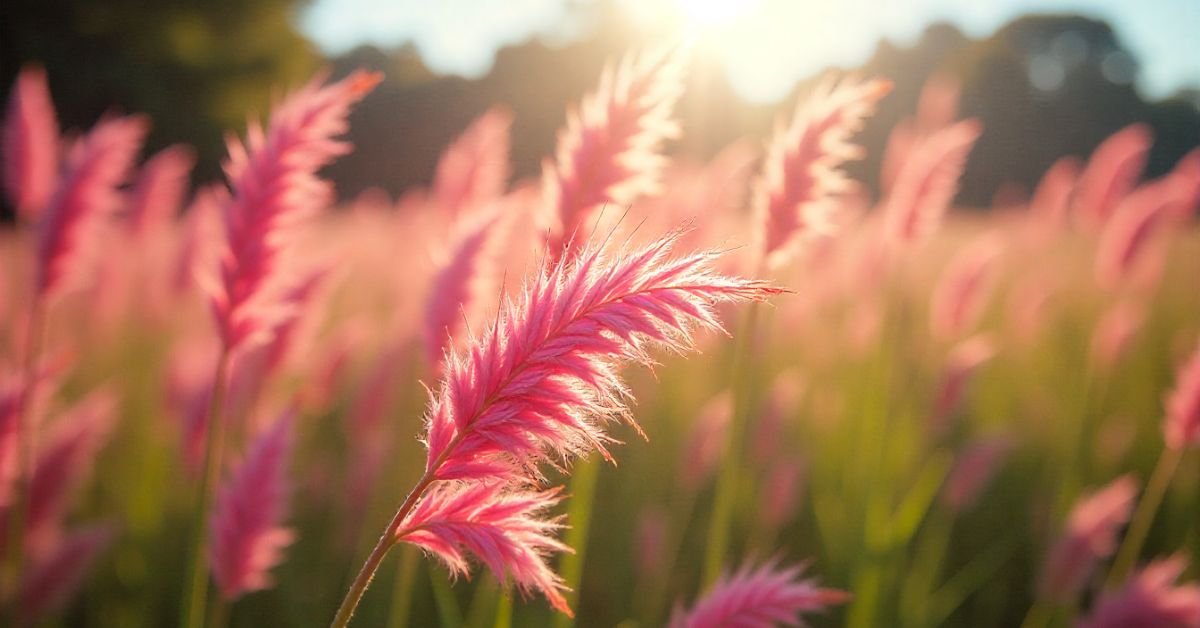Introduction
Pink pampas grass plants are tall ornamental grasses with soft, feathery pink plumes.In gardens and landscapes, they add charm and elegance. Known for their striking color and texture, they make a bold statement in any outdoor space. These grasses are hardy, low-maintenance, and loved by gardeners for their beauty.
Imagine a garden with tall pink plumes swaying in the breeze. They create a dreamy, romantic atmosphere. Many people choose them for their unique look and easy care. If you want a plant that stands out and turns heads, pink pampas grass is the answer.
These plants thrive in sunny spots with well-drained soil. Once established, they are drought-resistant, making them ideal for low-maintenance gardens. With proper planting and care, pink pampas grass can grow up to 10 feet tall. They also serve as natural privacy screens and stunning focal points in any yard.
Light
It grows best in full sunlight, where it produces tall, vibrant plumes. While it can tolerate partial sun, too much shade creates problems. Shady areas often hold extra moisture, which can lead to fungal diseases. For the healthiest growth, give your pampas grass plenty of bright sunlight.
Soil
Good soil is key to strong and healthy pampas grass. It prefers moist but well-draining soil that is rich in nutrients. Poor drainage can trap water around the roots, leading to rot or fungus. To keep your pampas grass thriving, always choose soil that allows water to flow through easily while still holding enough moisture for growth.
Water
When planting new pampas grass, water it deeply to help the roots settle in. For the first few months, give it occasional watering to support healthy growth. Once established, natural rainfall is usually enough. Extra watering is only needed during long periods of drought.
Temperature and Humidity
Grass of the Pampas grows in hot and humid climates in South America. It is also a tough plant that can handle cold winters and even light snowfall. This resilience makes it a great choice for many different regions.
Fertilizer
Pampas grass doesn’t depend much on fertilizer, but it can benefit from it. After pruning, a balanced fertilizer can encourage fresh growth and fuller plumes. Avoid overfeeding by always checking the product instructions.
Types of Pampas Grass
There are many varieties of pampas grass, but these three are among the most popular and widely grown:

- ‘Pumila’ (Dwarf Pampas Grass): A compact variety that grows up to five feet tall. Its plumes range from pale yellow to ivory, making it perfect for smaller gardens or container planting.
- ‘Sunningdale Silver’: Known for its striking silver plumes, this variety can reach up to 10 feet tall. It grows more openly and doesn’t clump as much as dwarf types.
- ‘Rendatleri’ (Pink Feather Pampas): Landscapes are made vibrant with this variety’s bold pink plumes. It grows up to eight feet tall and is a true standout in any garden.
Pruning
Prune pampas grass once a year to keep it healthy and neat. Cut back the foliage to about one to two feet from the ground. Use sharp shears or a trimmer for clean cuts. Remove dead leaves and old plumes to make space for new growth. Always wear gloves, as the leaves are sharp. Regular pruning encourages fresh, full, and vibrant plumes.
Propagating Pampas Grass
Division is the easiest way to propagate pampas grass. Divide the plant every few years to keep it healthy and encourage new growth. Always wear gloves and protective clothing, as the leaves are sharp. Early spring is the best time to divide, just as new shoots begin to appear. Use a sharp shovel to cut through the tough root system and separate the clump.
How to Divide and Replant
Carefully dig around the divided section until it can be lifted from the ground. Large clumps may take some effort to remove, so be prepared to work with them. Once separated, fill the hole left behind and replant the clump in a new spot. If planting near other pampas grasses, keep a distance of six to eight feet between plants. This spacing allows them plenty of room to grow and spread.
How to Grow Pampas Grass From Seed
Pampas grass can be grown from seed, but it often produces uneven results. Most seeds tend to grow into male plants, which do not have the showy plumes that female plants are prized for. As soon as the fluffy plumes appear in late summer or early fall, seeds can be collected. They are dark brown to black, narrow, long, and pointy. Female plumes usually contain more seeds than male ones.

Steps to Grow Pampas Grass From Seed:
- Lightly cover the seeds with nutrient-rich, well-draining soil.
- Cover the pots with a plastic bag or dome to trap warmth and moisture.
- Keep the pots in a bright location with indirect sunlight. Germination usually takes about three weeks.
- Transplant seedlings into larger pots once they are strong enough to handle.
- When seedlings begin to look bushy, plant them outdoors after the danger of frost has passed.
Potting and Repotting Pampas Grass
Dwarf pampas grass and smaller varieties grow well in containers, but they need space to thrive. You should always choose a large pot with enough room for the roots to spread. When the plant outgrows its container, either divide the clump or transfer it to a bigger pot.To repot, carefully lay the plant on its side and tap the pot to release the roots.. Move it into the new pot, fill with rich, well-draining soil, and make sure the container has drainage holes to prevent waterlogging.
Overwintering
Pampas grass is hardy and requires little care during winter. It is best to leave the foliage untouched until pruning time in late winter or early spring. The old leaves act as a natural layer of protection against the cold. For extra insulation, you can also add a layer of mulch around the base of the plant. This helps safeguard the roots and prepares the grass for healthy regrowth in spring.
Problems With Pampas Grass
Although pampas grass has very few pests or disease issues, it can still cause some challenges for gardeners. Below is a table outlining common problems, their causes, and how to avoid them.
| Problem | Cause | Prevention / Solution |
| Highly Flammable | Grass dries out easily and becomes a fire hazard. | Avoid planting near buildings, grills, or fire pits. Choose sterile varieties to prevent spreading. |
| Razor Sharp Blades | Leaf edges are sharp and can cut skin. | Always wear gloves and protective clothing. Plant away from walkways and play areas. |
| Attracts Critters | Tall, dense growth provides shelter for snakes and small animals. | Keep grass trimmed and avoid leaving food or birdseed nearby. |
| Dead Center Rot | Old, untrimmed foliage decays in the middle of the plant. | Prune each year and divide the clumps often to keep the plant healthy. |
How to Get Pampas Grass to Bloom
Pampas grass blooms best with full sun and well-drained soil. Allow enough room for it to grow tall and sturdy. Prune old growth in late winter to allow new plumes to form. Strong plants produce big, beautiful blooms.
Bloom Months

Plumes appear in late summer and continue into early fall. In warmer regions, they may last through winter if the grass is not cut down. Bloom time depends on climate and care.
What Does a Pampas Grass Flower Look and Smell Like?
Male and female plants produce separate flowers. Female plants are more common because their plumes are fuller, silkier, and showier. Plumes can be white, silver, or pink depending on the variety. Fresh plumes have little to no scent, but when dried, they give off a mild hay-like smell.
How to Encourage More Blooms
Plant pampas grass in full sunlight. Use soil that drains well. Avoid nitrogen-rich fertilizers, as they reduce blooming. Regular pruning and proper care help increase plume production.
Conclusion
Pampas grass adds beauty and elegance to any landscape. Grow it in full sun and well-drained soil for the best results. Prune it yearly to keep it healthy and strong. Handle it with care, as the leaves are sharp. With proper care, pampas grass will reward you with tall, graceful plumes season after season.
FAQs
Q1. How tall does pampas grass grow?
Pampas grass can grow between 8 to 12 feet tall, depending on the variety.
Q2. Is pampas grass hard to maintain?
No, pampas grass is low-maintenance and thrives with minimal care once established.
Q3. Can pampas grass grow in pots?
Yes, dwarf varieties grow well in large containers with proper soil and drainage.
Q4. Does pampas grass need fertilizer?
Not always. A balanced fertilizer after pruning can encourage new growth.
Q5. Is pampas grass safe for pets and children?
The leaves are sharp, so keep it away from play areas to prevent cuts.


